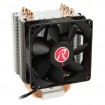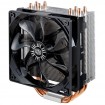Odd, my CPU was getting to 100C, so I bought a big CPU cooler (twice the normal size). That took it down to 80C, but it's gradually worked it's way back up to 100C again. Now I've slowed the CPU down to 85% of normal speed in the BIOS, and it's back to running at a more comfortable 70C. Something funny's going on here.
Yes, the heatsink is hot, heat is transferring correctly. The fan is working fine, hot air is blowing off it. The problem is the CPU is creating way too much heat. Faulty CPU? Faulty motherboard? Anything I can do apart from just replacing one or the other? The CPU is an i5 3570K and has been run flat out for years (BOINC).
The BIOS won't let me lower the speed any more. I've reduced the base clock from 100 to 95, it won't go lower than that. It ignores me when I lower the multiplier (which is odd as it's a K CPU which should be unlocked?) But I have managed to disable the turbo function, so it doesn't jump up to 38 multiplier. So I've ended up with a 3.2GHz CPU instead of 3.8GHz.
Yes, the heatsink is hot, heat is transferring correctly. The fan is working fine, hot air is blowing off it. The problem is the CPU is creating way too much heat. Faulty CPU? Faulty motherboard? Anything I can do apart from just replacing one or the other? The CPU is an i5 3570K and has been run flat out for years (BOINC).
The BIOS won't let me lower the speed any more. I've reduced the base clock from 100 to 95, it won't go lower than that. It ignores me when I lower the multiplier (which is odd as it's a K CPU which should be unlocked?) But I have managed to disable the turbo function, so it doesn't jump up to 38 multiplier. So I've ended up with a 3.2GHz CPU instead of 3.8GHz.





